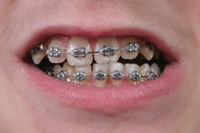If it’s been a while since you’ve worn braces, you’re in for a surprise. A wide variety of alternatives — many introduced in the past 10 years — make braces easier to wear, less painful and more attractive for your preteen. And somehow, a taunt of “ceramic mouth!” doesn’t hold the same verbal punch as “metal mouth!” Here’s an overview of how technology and advances have increased toothy grins all around.
 Metal: Surprisingly, many preteens prefer the traditional metal braces, says Robert James Bray, the president of the American Association of Orthodontists. Kids love the colorful elastics that go around each bracket. (Check out the Web site of local orthodontist Mario Chorak to play with the interactive color bands.)
Metal: Surprisingly, many preteens prefer the traditional metal braces, says Robert James Bray, the president of the American Association of Orthodontists. Kids love the colorful elastics that go around each bracket. (Check out the Web site of local orthodontist Mario Chorak to play with the interactive color bands.)
But these aren’t the braces you remember. “Now, the brackets are smaller and more comfortable, and applied with glue,” Bray says, instead of that old-school concrete sludge. It’s different than what we adults endured, so spare your kid the “back in my day” horror stories. “There’s not as much discomfort, we can put braces on in a short amount of time, and we use light, space-age wires that are very, very flexible,” Bray says.
Self-ligating: The most well established is the Damon brand, but all self-ligating braces work on the same principle: There’s no need for ties or elastic bands, because the wire connecting the brackets slides as teeth shift. Because of the braces’ gentle movement and self-expansion, office visits can be cut down to once every eight weeks. Damon is sometimes preferred for individuals with tooth crowding (too many teeth) — easier than pulling teeth, indeed.
Invisalign: The Invisalign brand crafts a series of removable, clear aligners, which are custom-made from your teen’s tooth impressions. Aligners are replaced every three weeks or so, until teeth are straight. No wires, no metal bits. To get these, kids must demonstrate responsibility, says Dr. Elizabeth Lyons, an orthodontist at North Seattle Orthodontics. The trays must be worn for at least 22 hours a day and only removed during dining. “Some kids are great and on board, and they’ll wear them,” she says. Other kids won’t wear orthodontic appliances “if they’re not glued into the mouth,” she says.
Lingual or invisible braces: These braces and wires are attached to the back of the tooth, rendering them almost invisible to others. Computer-based imaging technology creates brackets customized to the tooth’s shape and size. This new approach, called “iBraces,” works well for older teens who have no baby teeth remaining.
SureSmile: With SureSmile, your tween’s orthodontist uses a light scan to obtain a 3-D image of the teeth and creates a personalized, virtual model for desired tooth movement. Then, a robot (yes, a robot!) bends an alloy wire based on the treatment plan. Seattle mom Lori Mina signed her son Jayme up for the SureSmile treatment plan at age 13, after his adult molars came in. “It cuts the treatment time and increases accuracy,” Mina says, and the cost is reasonable. “The bottom line was that SureSmile was only 10 percent more, but it would cut down appointments and the treatment time by about six months.”
Colorful choices: Bored of chrome? Kids today can also choose tooth-colored and clear brackets. The thin metal wires are still visible but less obvious. If you only buy the very best for your little princess (or prince), and you’ve got a queen’s budget to match, consider 24-karat gold braces. Wild Smiles offers heart-, football-, and flower-shaped silver brackets, along with four other fun shapes. They go on like regular metal braces — they’re just a bit more fun. Orthodontists don’t always stock this brand, but the brackets can be special-ordered by your child’s orthodontist.
Which method should you choose?
It’s up to you and your orthodontist to decide which method is right for your child. Your child’s pearly whites remain mute on which approach is best. “The tooth doesn’t know what’s moving it,” Bray says, and so comfort and aesthetics can also be considered.
However, some methods are better than others for either simple or complex alterations to the bite, tooth alignment and tooth straightening. The orthodontist can tell you whether your child’s bite could benefit more from SureSmile, traditional metal braces or Invisalign. And some methods can only be used on older teens or tweens whose adult teeth have come in.
As for expense, Lyons says most options are covered similarly in comprehensive health-care plans. But a few approaches incur extra expense, particularly those with extra lab and technology fees. Request a side-by-side cost comparison before making your decision.
At the end of treatment, will your tween smile her way through adolescence? Orthodontists can’t guarantee a grin, but even her pout will be prettier.
Lora Shinn writes for magazines like Parenting, KIWI and Pregnancy. She spent her tween and teen years in various orthodontic appliances; she’s glad her days of heavy metal are over.
When to visit the orthodontist
Orthodontists suggest that children first come in around age 7 for a screening to assess what’s coming up (and your financial hit) over the next five to seven years. Some children are fast-tracked into braces, particularly for bite or tooth-crowding issues. Others can wait until age 12 or so, after the adult teeth arrive.









